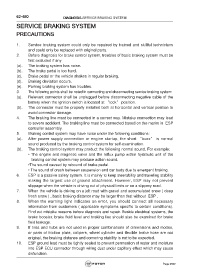Page 2532 - Foton Workshop Manual - Sauvana
P. 2532
62-480 DIAGNOSIS-SERVICE BRAKING SYSTEM
SERVICE BRAKING SYSTEM
PRECAUTIONS
1. Service braking system could only be repaired by trained and skillful technicians
and could only be replaced with original parts.
2. Before diagnosis for brake control system, troubles of basic braking system must be
first excluded if any
(a). The braking system has noise.
(b). The brake pedal is too hard.
(c). Brake pedal or the vehicle shakes in regular braking.
(d). Braking deviation occurs.
(e). Parking braking system has troubles.
3. The following points shall be noted in connecting and disconnecting service braking system:
(a). Relevant connector shall be unplugged before disconnecting negative cable of the
battery when the Ignition switch is located at “lock” position.
(b). The connector must be properly installed both at horizontal and vertical position to
avoid connector damage.
4. The braking line must be connected in a correct way. Mistake connection may lead
to severe accident. The braking line must be connected based on the marks in ESP
controller assembly.
5. Braking control system may have noise under the following conditions:
(a). After power supply connection or engine startup, the short “buzz” is normal
sound produced by the braking control system for self-examination.
(b). The braking control system may product the following normal sound. For example:
• The engine and magnetic valve and the reflux pump within hydraulic unit of the
braking control system may produce action sound.
•The sound caused by rebound of brake pedal.
• The sound of crash between suspension and car body due to emergent braking.
6. ESP is a passive safety system. It is mainly to keep steerability and traveling stability
making the largest use of ground attachment. However, ESP may not prevent
slippage when the vehicle is driving out of physical limits or on a slippery road.
7. When the vehicle is driving on a jolt road with gravel and accumulated snow ( deep
fresh snow ) , basic braking distance may be larger than that without ESP .
8. When the warning light indicates an error, you should connect all necessary
information from customers ( applicable symptoms specific to certain conditions).
Find out mistake reasons before diagnosis and repair. Beside electrical systems, the
brake booster, brake fluid level and braking line should also be examined for brake
fluid leakage.
9. If tires and hubs are not used in proper combinations of dimensions and modes,
or parts of friction plate, calipers, wheel cylinder and flexible brake hose are not
original, the braking distance and cornering stability is not to be expected.
10. ESP ground lead must be tightly sealed to prevent permeation of water and moisture
into ESP ECU connector through wiring duct under capillary effect which may cause
disfunction.
Page 2532

